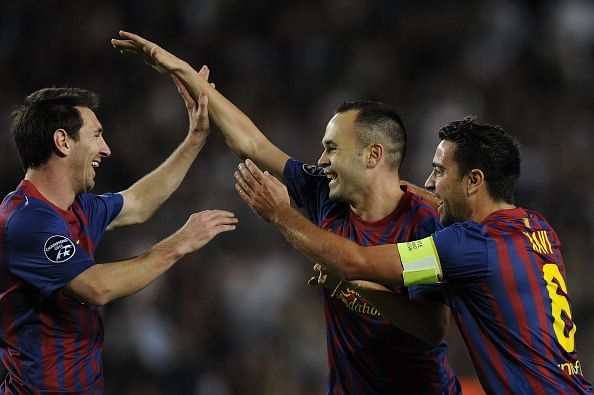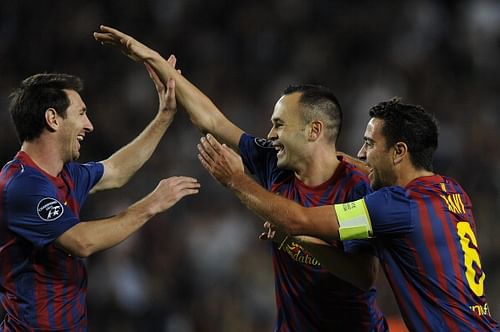
The importance of home grown players

Lionel Messi, Andres Iniesta, and Xavi – from Barcelona’s famed youth academy La Masia
Over the past few years, spending on transfers and wages by football clubs has increased dramatically. 7 of the 10 most expensive transfers have taken place in or after 2009, three of them occurring in this (incomplete) transfer window. Higher fees, and the greater brand value of every star footballer has also led to an inflation in the wage rate for footballers. While this is all good news for the players, it gives the boardroom staff a right old head-ache. The higher costs lead to lower profits (if any), leaving a number of clubs closer to insolvency. In order to stem the rot, UEFA introduced Financial Fair Play, a scheme that prods clubs to live within their means. So, with a sort of cap enforced on their transfer spending, clubs are forced to look inwards for their supply of players, as a result of which, greater emphasis is suddenly being placed on youth academies, and academy products.
This shift in focus, however, has been seen only in the media. The smart, and as an extension successful clubs have always utilised this source very efficiently. Cast your mind back to some of the successful outfits of the past, and you’ll always see a large contingent of home grown players, or players from the home country. Think of Ajax, led by Cruyff, or Bayern, with the likes of Beckenbauer, Muller, Roth, Maier, and Hoene?. This team won three consecutive European Cups in the 70?s, and also formed the core of the West German side that won the World Cup in 1974, the Euros in 1972, and finished runners up in 1976.
Moving forward a few years, the Manchester United team of the 1990s and early 2000s dominated English football, and pulled off a spectacular treble in 1999. At the core of the side were players like Beckham, Butt, Giggs, Scholes, and the Nevilles – all academy graduates – along with a few other Englishmen like Cole and Sheringham. More recently, the dominant force of the last 8 years or so has unarguably been Barcelona, and no prizes for guessing where key players like Xavi, Iniesta, Pique, Puyol, and Messi are from. Going a little further back, all of us are aware of the Celtic team that humbled Il Grande Inter back in 1967. The fact that stood out about that team managed by Jock Stein was that all of their players were born within an 11 mile radius of Glasgow.
So what is it about these home grown players that make their teams so good, and so successful? A number of different factors really. Some of which are:
Cultural Factors
As we all know, most clubs across the world have a few non-local players. So, when players from different parts of the globe congregate to play together, as part of the same team, there are bound to be cultural and communication gaps that need bridging. However, this is easier said than done, and is an aspect that we overlook more often than not. Even if the player does settle, and manage to grasp the basics of the new language, he can never truly adapt his thinking to align it with that of a foreigner.
According to Dr. Ranee Kaur Banerjee, an expert in the field of communications, this is because our language most definitely influences our thoughts and our actions, and some linguists believe that language moulds thought, and by extension, actions. A simple non-football example would be the way Germans and Spaniards refer to keys. In Spanish, a key is feminine, and in German, it’s referred to in the masculine gender. As a result, we see keys made in Spain that are designed with a lot more flair, and a lot more attention is paid to aesthetics, whereas German keys are designed with function kept in mind, and hence, a lot less attention is paid to aesthetic details. The same is seen with regard to bridges.
The implication of this phenomenon on football is profound. We’ve all noticed the difference in the play of international teams that come from countries that speak Romance languages (Spain, Italy, Brazil, Argentina) and teams from Northern Europe (Germany and England). The former play a game with a lot of importance placed on style and flair. We almost always see intricate passing patterns, and beautiful moves. With the latter, we see a style that places greater stress on functionality, and as a result, the physical aspect is given precedence. Moving the ball forward quickly is also seen as effective, and therefore prioritised over possession by most clubs.
How is this related to home grown players being more effective? The aforementioned differences are found between Spaniards and Germans, two neighbouring countries. Most club sides have to integrate players from not only different countries, but from across the world. A typical European top division club has players from South America, Europe, Africa, and sometimes even Asia. Think of how difficult it can be to integrate these elements and get them on the same page, to co-ordinate well, and be effective as a team. The lack of synergy is startling when contrasted with synergy shown by a club with a large contingent of home grown players, like Barcelona.
he key to overcoming this difficulty would be to have players who think in the same language together. Of course, Shinji Kagawa could learn English and get along with his mates, but if he doesn’t think in English, he won’t be on the same page as say, Welbeck, who’s thought process will be very different.